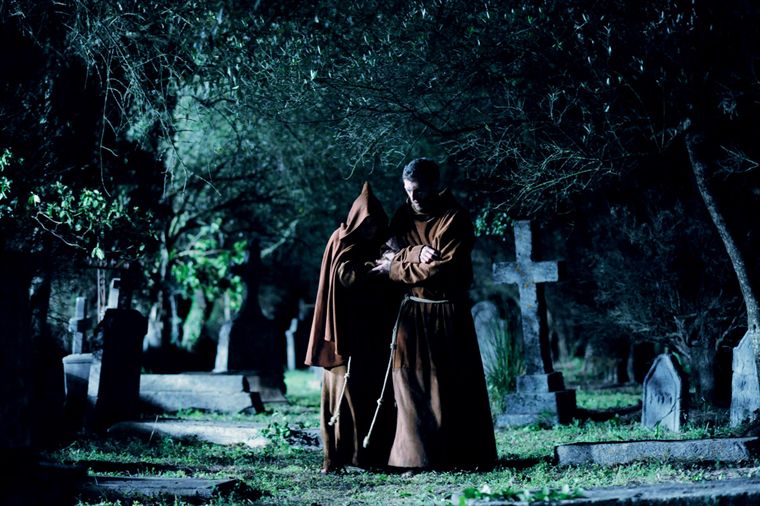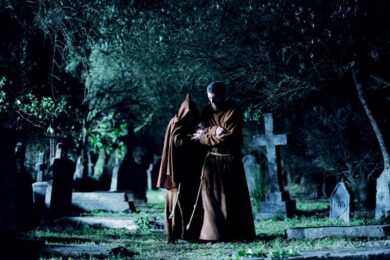A man meets the devil in the midst of the Spanish desert; a ghost bathed in shimmering white light materialises in a graveyard to deliver a macabre prophecy; a monk is seduced by a nubile young woman… Scenes like these are rare in contemporary cinema – particularly in films by Palme d’Or-nominated French auteurs renowned for their Hitchockian, contemporary thrillers. But such are the key moments in the latest work by Dominik Moll, previously of Harry, He’s Here to Help, and Lemming.
Vincent Cassel plays Father Ambrosio, the saturnine capuchin of the title, who was abandoned as a baby on the steps of a monastery. Now all grown up, he is amongst the most devout, respected and imperious of the order. So pious is his aspect that his sermons are liable to induce fainting in the young women in attendance. A bit like Take That doing ‘Back For Good’ then, but with rather less finger-clicking and swaying from side to side. But as the story progresses, Ambrosio begins to show signs of hubris and inner torment. His faith is put to the test in particular by the entrance into the monastery of a figure introduced as Valerio: a young boy, hideously disfigured in a fire which killed his family, who now wears an eerie featureless mask. Valerio soon develops a powerful attachment to Ambrosio. The latter meanwhile is plagued by discomfiting dreams and punishing headaches.
Adapted from a famously immoral gothic morality tale written by Matthew Lewis, this film of an 18th century book, set in the 1600s, feels strangely out of time in a number of respects, full of curiously antiquated techniques like iris-outs and colour negatives. In a recent interview with the DVD Outsider website, Moll referred to "numerous historical absurdities" in novel and film alike – and it was precisely this estrangement from traditional notions of period authenticity that attracted him to this particular source material. But aside from that, there is something distinctly un-contemporary about this film.
There have been numerous French horror films over the last decade – in sufficient numbers for critics like James Quandt and Jonathan Romney to refer to a ‘New French Extremity’ – inspired in part by outbursts of real violence on the streets of Paris and in part by the appetite of premium pay television channel, Canal+, for funding movies with a lot of sex and violence (violent shockers À L’Interieur, Ils, Sheitan, Martyrs, as well as more auteurist fare such as Catherine Breillat’s Romance, Marina de Van’s Dans Ma Peau, and Philippe Grandrieux’s Sombre, have all felt the benefit of Canal+’s largesse).
The Monk, likewise lists Canal+ amongst its numerous backers, but one can no more imagine a scene, like that which opens Xavier Gens’s Frontière(s), appearing to cut real footage of the 2005 riots in the Parisian banlieues into the narrative, than one can imagine Vincent Cassel keeping all his clothes on for the entire length of any given feature. Nor, I somehow suspect, is there any great reason to fear Gaspar Noé or Alexandre Aja trying to scare up some funding for a movie based on Ann Radcliffe’s Mysteries of Udolpho any time soon. Flesh and blood may have staged a comeback in France, the gothic decidedly has not.
To find a comparable sense of gothic surrealism in French cinema one has to go back to 70s fare like Jean Rollin’s Requiem pour un vampire, or Claudio Guerín’s weird Franco-Spanish co-production, La cloche de l’enfer. Or even earlier to certain works of Buñuel, like Viridiana, or his early adaptation of Poe’s The Fall of the House of Usher, which he wrote for Jean Epstein.
In fact, Moll’s is not the first adaptation of Lewis’s novel. Written when the future M.P. for Hindon in Wiltshire was scarcely even of age, the book was excoriated at the time by Samuel Taylor Coleridge as the sort of novel which "if a parent saw it in the hands of a son or daughter, he might reasonably turn pale.” None other than the Marquis de Sade saw it as a reaction to provincial British fears stoked up by the French Revolution. Lewis attempted to temper charges of blasphemy with a toned-down second edition and an apologetic preface, but the controversy which continued to hang over it only helped its popular success. Bath-born British composer, Edward Loder made of it an opera in 1855, Raymond and Agnes; and Antonin Artaud used it as source material for a novel of his own. Spanish director, Francisco Lara Polop made a film from the book in 1990, starring Paul McGann (released on video as Seduction Of A Priest). But the immediate source for Moll’s film seems to be the 1972 production by Positif writer, Ado Kyrou, based on an earlier script by Buñuel himself.
I rather suspect that the impulse behind filming this novel one more time, for Moll, came out of a reaction to the too-persistent accusations of being ‘Hitchcockian’ levelled at his two previous pictures. Harry was widely compared to Strangers On A Train; Lemming, with somewhat less justification, to The Birds. And in France, to be in Hitchcock’s shadow means to be, just as much, in the shadow of Claude Chabrol and the magazine he wrote for, Cahiers du Cinéma. What better way to escape from the cloak of the Cahiers than to take a book previously adapted by a writer associated with Positif, the arch-rival to Cahiers du Cinéma in the 1960s, which famously regarded Hitchcock with little short of disdain?
In truth, such flights of absurdism as we find in The Monk have never been foreign to Dominik Moll. Think, for instance, of the flying monkey dream sequence in Harry. What has happened with The Monk, in a sense, is that the dream logic of Les singes volants has broken the boundaries of sleep time and invaded the entire picture. The repeated dream sequences in The Monk are not only some of the most brightly lit scenes in this inky, richly photographed film; they are also amongst its more prosaic moments – as if the always-already oneiric Ambrosio is condemned to touch the real only in a dream.
The Monk will be playing at the Glasgow Film Festival on February 19th and 20th. Details here.



